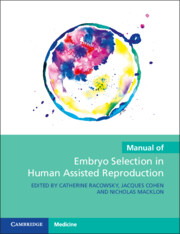Book contents
- Manual of Embryo Selection in Human Assisted Reproduction
- Manual of Embryo Selection in Human Assisted Reproduction
- Copyright page
- Contents
- Contributors
- Preface
- Chapter 1 Introduction
- Chapter 2 Embryo Developmental Programming
- Chapter 3 Embryo–Maternal Interactions
- Chapter 4 The Sperm’s Role in Embryo Development
- Chapter 5 The Oocyte’s Role in Embryo Development
- Chapter 6 The Laboratory’s Role in Embryo Development
- Chapter 7 Handling of Gametes and Embryos
- Chapter 8 Noninvasive Morphological Selection of Oocytes
- Chapter 9 Prospects for Bioenergetics for Embryo Selection
- Chapter 10 Static Morphological Assessment for Embryo Selection
- Chapter 11 Dynamic Morphological Assessment for Embryo Selection
- Chapter 12 Noninvasive Analysis of Embryo Nutrient Utilization for Embryo Selection
- Chapter 13 Genomics for Embryo Selection
- Chapter 14 Biopsy Techniques from Polar Body to Blastocyst
- Chapter 15 Cell-Free DNA Analysis for PGT-A
- Chapter 16 What Science May Come for Embryo Selection?
- Epilogue
- Index
- References
Chapter 14 - Biopsy Techniques from Polar Body to Blastocyst
Published online by Cambridge University Press: 26 April 2023
- Manual of Embryo Selection in Human Assisted Reproduction
- Manual of Embryo Selection in Human Assisted Reproduction
- Copyright page
- Contents
- Contributors
- Preface
- Chapter 1 Introduction
- Chapter 2 Embryo Developmental Programming
- Chapter 3 Embryo–Maternal Interactions
- Chapter 4 The Sperm’s Role in Embryo Development
- Chapter 5 The Oocyte’s Role in Embryo Development
- Chapter 6 The Laboratory’s Role in Embryo Development
- Chapter 7 Handling of Gametes and Embryos
- Chapter 8 Noninvasive Morphological Selection of Oocytes
- Chapter 9 Prospects for Bioenergetics for Embryo Selection
- Chapter 10 Static Morphological Assessment for Embryo Selection
- Chapter 11 Dynamic Morphological Assessment for Embryo Selection
- Chapter 12 Noninvasive Analysis of Embryo Nutrient Utilization for Embryo Selection
- Chapter 13 Genomics for Embryo Selection
- Chapter 14 Biopsy Techniques from Polar Body to Blastocyst
- Chapter 15 Cell-Free DNA Analysis for PGT-A
- Chapter 16 What Science May Come for Embryo Selection?
- Epilogue
- Index
- References
Summary
Chromosomal aneuploidies mainly affect blastocysts produced from advanced maternal age women (≥35yr). Nevertheless, also in younger patients the aneuploidy rate is ~30%. If one of the partners is carrier of a structural rearrangement, the risk of producing aneuploid gametes is high, independently of woman age. Moreover, ~2% of the couples are carrier of an inheritable monogenic disease. To circumvent the risk of transferring affected and/or chromosomally-abnormal embryos, pre-implantation genetic testing has been introduced in IVF. Throughout the last 30 years, three biopsy approaches have been implemented: blastomere biopsy at the cleavage stage, polar body biopsy from oocytes/zygotes, and trophectoderm biopsy from the blastocyst. The latter is the current gold standard. Here we describe the three approaches along with tips and troubleshooting inherent to trophectoderm biopsy, to correctly perform it, optimize its outcomes, and cope with peculiar situations.
- Type
- Chapter
- Information
- Manual of Embryo Selection in Human Assisted Reproduction , pp. 149 - 157Publisher: Cambridge University PressPrint publication year: 2023



